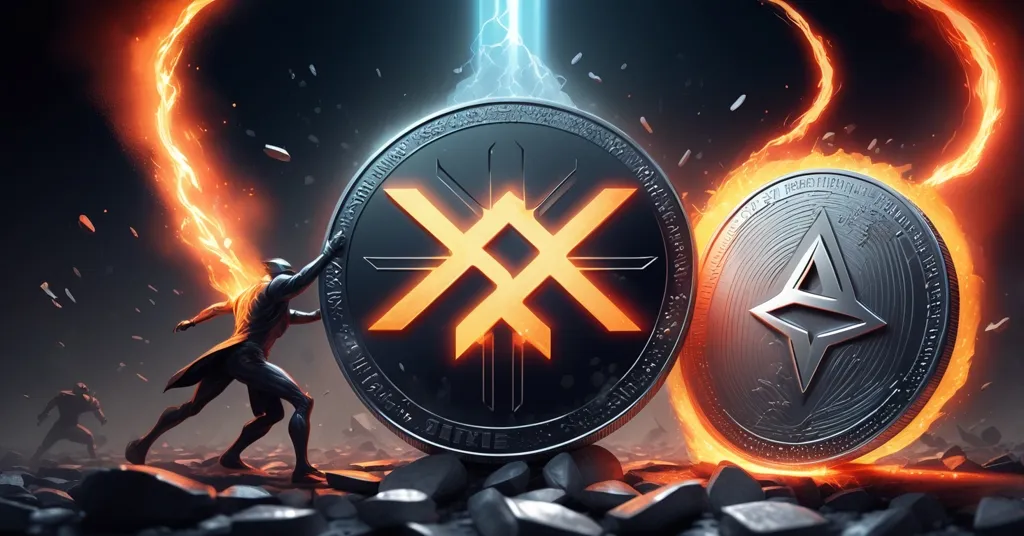XRP and Mutuum Finance: Top Altcoins for Beginners in 2025 Under Scrutiny

Top Altcoins for Beginners in 2025: XRP and Mutuum Finance Under the Microscope
As whispers of a crypto bull run grow louder, first-time investors are eyeing altcoins for a mix of safety and explosive potential. Two tokens stand out in this speculative frenzy: XRP, a long-standing player with signs of a price breakout, and Mutuum Finance (MUTM), a newcomer in the DeFi space promising big returns from its presale. Let’s cut through the noise and dissect what these altcoins offer—and what they risk—for those new to the game.
- XRP’s Stability: Trading near $2.11, with technical patterns hinting at a breakout to $2.6–$3 by mid-2025.
- Mutuum’s Hype: DeFi presale raised $11.3 million, with wild claims of 100x gains post-launch.
- Risk Reality: XRP carries legal baggage, while Mutuum is an untested gamble in a risky sector.
Why Altcoins Draw Crowds in a Bull Run
Altcoins—cryptocurrencies other than Bitcoin—often steal the spotlight during bull runs, those periods of rampant market optimism where prices can soar. History shows this pattern clearly: in 2017, tokens like XRP surged over 36,000% at their peak, while the 2021 run saw altcoins like Solana rocket up by thousands of percent. For first-time investors, altcoins promise faster gains than Bitcoin’s steadier climb, often driven by hype and innovation narratives. But here’s the flip side: they’re also prone to catastrophic crashes, with many disappearing into obscurity after the boom fades. Bitcoin, with its unmatched decentralization and market dominance (holding over 50% of total crypto market cap as of late 2023), remains the safer anchor. Altcoins, while exciting, are experiments—some revolutionary, most forgettable. So, as we unpack XRP and Mutuum Finance, keep in mind they’re side bets, not the main play, in a game where Bitcoin still rules. If you’re new to this space, consider exploring resources on top altcoins for first-time investors to better understand the landscape.
XRP: The Veteran with Legal Shadows
XRP, tied to Ripple, has been a crypto staple since 2012, designed for fast, cheap cross-border payments. Unlike Bitcoin’s peer-to-peer rebellion against centralized systems, XRP powers RippleNet, a network used by over 300 financial institutions worldwide to settle transactions in seconds—think of it as a blockchain-based alternative to SWIFT, the old-school banking system. Trading at around $2.11 recently, with a high of $2.206 in the last 90 days, XRP shows signs of consolidation after climbing from a local low of $1.91. Chart watchers point to a symmetrical triangle pattern, where price swings narrow over time, often signaling a big move. Analysts predict a potential XRP price breakout between July and September 2025, with modest targets of $2.6 to $3, though some throw out wild numbers like $8 or even $27 based on historical trends and Fibonacci extensions—a technical tool projecting price levels from past movements.
Market sentiment leans bullish, backed by on-chain data showing whale accumulation, meaning large investors are buying up XRP and holding off on sales, a sign they expect gains. Analyst DustyBC Crypto recently posted on social media:
“XRP under $2 is incredibly cheap. Bookmark this post, look back in 6 months.”
But not everyone’s sold. CasiTrades warns that XRP needs to smash through resistance levels at $2.25 and $2.69 to confirm a real trend shift, not just a temporary spike. For beginners, XRP’s appeal lies in its longevity and real-world use, making it less volatile than newer tokens. If you’re curious about its fundamentals, check out this detailed overview of the XRP cryptocurrency and its ledger. Yet, there’s a massive elephant in the room: an unresolved lawsuit with the U.S. Securities and Exchange Commission (SEC). Since 2020, the SEC has argued XRP is a security, not a currency, which could subject it to strict regulations. As of late 2023, no final ruling has emerged, but a loss for Ripple could gut XRP’s price overnight and scare off institutional partners. This isn’t just a footnote—it’s a glaring risk that even “safe” altcoins carry, unlike Bitcoin, which has dodged such existential threats through sheer decentralization.
From a purist’s view, XRP’s cozy relationship with banks and Ripple’s centralized control (holding a significant chunk of XRP supply) clash with crypto’s ethos of freedom from middlemen. Still, I’ll give credit where it’s due: XRP fills a payments niche Bitcoin isn’t built for, offering speed and cost savings that could drive adoption if legal hurdles clear. For first-timers, it’s a calculated bet, but can it shake off its regulatory chains to deliver on those bullish charts? That’s the million-dollar question. For community-driven insights, you might find some interesting XRP price predictions for 2025 floating around online forums.
Mutuum Finance: DeFi Dream or Hype Machine?
Now, let’s pivot to the speculative deep end with Mutuum Finance (MUTM), a project in the Decentralized Finance (DeFi) arena. DeFi uses blockchain to recreate financial services—think lending, borrowing, or earning interest—without banks or brokers. Mutuum promises a platform where users control their funds, depositing USDT (a stablecoin pegged to the U.S. dollar) to earn passive income via interest rates that adjust with market conditions. It’s still in presale, having raised over $11.3 million from 12,600+ investors in its fifth stage at $0.03 per token. The next round jumps to $0.035, with a launch price set at $0.06. What’s got tongues wagging are community projections of post-launch prices hitting $2.50, or even a laughable 100x gain to $10 by year-end 2025. If I had a satoshi for every 100x promise in crypto, I’d be retired on a yacht by now. Learn more about their ongoing Mutuum Finance presale success if you’re considering jumping in.
Mutuum touts innovation with its trustless, automated lending and borrowing system, aiming to cut out the bloated intermediaries of traditional finance—a mission we can get behind. They’ve also partnered with CertiK, a blockchain security firm, for a $50,000 bug bounty program split into critical, major, minor, and low vulnerability tiers. This is no small gesture; DeFi hacks drained $1.7 billion in 2022 alone, per Chainalysis, so security matters. But let’s not pop the champagne yet. Mutuum’s untested—its platform isn’t live, and specifics on how interest rates are calculated or how it differs from proven DeFi giants like Aave or Compound are thin. For a broader perspective on security, you can explore this analysis of DeFi projects like Mutuum. Presale success doesn’t guarantee longevity; for every DeFi winner, there’s a Terra/Luna collapse or a smaller rug pull—where devs vanish with investor cash—littering the landscape. The $11.3 million haul is flashy, but those 100x claims? Pure fantasy, unsupported by data or expert analysis, just community cheerleading at its worst.
For beginners, Mutuum is a high-stakes gamble, not a safe harbor. DeFi’s potential to disrupt is real, but so is its track record of catastrophic failure. Some might argue presales offer early-mover advantage, but with over 50% of new tokens fizzling out within a year, per CoinGecko data, the odds aren’t in your favor. Mutuum’s hype feels like a well-marketed mirage—tempting, but likely to vanish under scrutiny. If you’re weighing the risks, there are discussions on platforms like potential risks of Mutuum Finance presales that might offer additional insight. Proceed with extreme caution, or better yet, watch from the sidelines.
XRP vs. Mutuum: Weighing Risk and Reward
So, how do these altcoins stack up for first-time investors? XRP offers a semblance of stability with its market history and institutional backing, but the SEC lawsuit could be a knockout punch. Its potential gains, even at bullish targets of $3, are modest compared to altcoin moonshots, making it a slower, safer play. Mutuum, on the other hand, dangles massive returns but embodies DeFi’s wild west—untested, speculative, and ripe for disaster. Where XRP strays from crypto’s decentralized roots via Ripple’s control, Mutuum at least nods to the ethos with its trustless model, though it’s far from proven. For portfolio fit, XRP might warrant a small slice for cautious exposure to payments innovation, while Mutuum is strictly for those with cash to burn. Neither holds a candle to Bitcoin’s battle-tested resilience, but they target niches BTC doesn’t touch.
Bitcoin as the North Star: Where Altcoins Fit
Let’s zoom out. Bitcoin remains the king of crypto, commanding over half the market’s total value and surviving every crash since 2009 through sheer decentralization. Its censorship resistance and store-of-value status make it the ultimate safe haven in this space, dwarfing altcoins in reliability. XRP’s payments utility and Mutuum’s DeFi experimentation are side shows—interesting, sometimes useful, often distracting. Bitcoin doesn’t need to be everything; it’s the foundation. If you’re new to crypto, limit altcoin exposure to 10–20% of your portfolio, per common investor wisdom, and anchor the rest in BTC. That’s not maximalism for the sake of it; it’s survival math in a market where 90% of altcoins historically lose relevance. Altcoins can complement a strategy, but they’re not the core—treat them as high-risk spice, not the main dish. For a deeper dive into building a balanced portfolio, check out this guide on altcoin investments for beginners in 2025.
Key Takeaways and Questions for Crypto Enthusiasts
- Is XRP a safe bet for beginners?
Safer than unproven tokens due to its history and use in payments, but the ongoing SEC lawsuit could crater its price if Ripple loses. - What fuels XRP’s bullish outlook for 2025?
Technical chart patterns point to a breakout by mid-2025, with targets of $2.6–$3, backed by large investors buying and holding. - Should first-time investors dive into Mutuum Finance’s presale?
The $11.3 million raised is enticing, but untested DeFi projects carry huge risks of failure or scams—tread carefully or steer clear. - Are Mutuum’s 100x gain predictions realistic?
No, these claims lack data or expert backing, smelling more of hype than substance in a sector known for broken promises. - How do XRP and Mutuum align with crypto’s core principles?
XRP’s centralization via Ripple clashes with decentralization, while Mutuum’s DeFi model is closer but unproven against Bitcoin’s ethos. - How should beginners balance Bitcoin and altcoins?
Prioritize Bitcoin for stability, keeping altcoins like XRP or Mutuum as small, speculative portions—think 10–20% max of your holdings. - What broader factors could impact altcoin gains in a bull run?
Macroeconomic headwinds like inflation or regulatory crackdowns could dampen rallies, regardless of technical optimism.
Navigating the altcoin maze as a first-time investor demands sharp skepticism and a tight grip on reality. XRP offers a foothold with its established role, but legal uncertainties could unravel its story. Mutuum Finance tempts with DeFi dreams and presale buzz, yet it’s a textbook high-risk play in a field strewn with wreckage. We cheer blockchain’s potential to upend the old financial guard, but not every token is a game-changer—some are just shiny traps. Bitcoin stays the compass in this chaos, a reminder of what crypto was born to do. If you’re venturing into altcoins, research relentlessly, ignore the moonshot sirens, and never risk what you can’t lose. This isn’t just a market; it’s a battlefield. Stay sharp.



